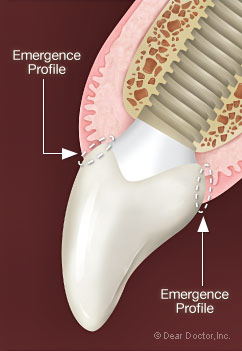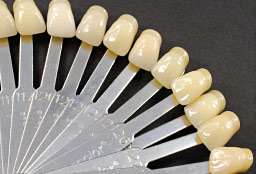Matching Teeth & Dental Implants
Making dental implant crowns look real
 |
I have been discussing options to replace a missing front tooth, but my dentist tells me it's not always so easy to match an implant with a (natural) tooth. Can you elaborate?
Dear Rachel,
We know how and why implants successfully fuse to bone, but making the crowns (the parts of the teeth that attach to them) look real is another matter. That is where art really meets science. What drives the result is how the tooth or crown shape actually emerges through the gum tissues, and the ability to identically match the color to the adjacent natural teeth. What follows are some of the predictive factors and criteria for success that dentists involved in implant dentistry have learned through evidence based research, clinical practice and experience over the years.
The Bone Sets The Tone
The first factor is that there needs to be an adequate volume of bone and gum tissue, in the right position to anchor or support an implant. This means that when a tooth is lost, the remaining bone of the tooth socket has to be managed delicately so as to retain as much bone as possible, avoiding the natural tendency of the socket to collapse and resorb (melt away). This can be done by:
- Minimizing trauma during tooth removal, especially important if an immediate implant is to be placed the same day with a temporary crown;
- Using “bone grafting” materials and techniques to minimize resorption;
- Rebuilding bone where lost with regenerative surgical techniques.
These techniques allow an implant to be optimally positioned in order to place a crown in perfect position.
Good Neighbors
Believe it or not the second factor is the amount of bone on the adjacent tooth/teeth. Maintaining a normal volume and height of bone attached to the adjacent teeth actually controls the height of the “papillae,” the little pink triangles of tissue that fill the spaces in the areas beneath where the teeth contact each other. If bone is lost on either side of an implant against a natural tooth, there is no guarantee that the papillae (those small, pink triangle of gum tissue between teeth) will regenerate fully, leading to what we dentists refer to as “black hole disease.”

Tissue Is The Issue
The third factor to consider is the genetic tissue type you are born with. It is a lot more difficult to achieve a great result with genetically thin tissue than it is with thicker tissue types. Think of the gingival (gum) tissues like a curtain, the thicker the curtain, the more wear and shrink resistant it will be. Thin tissues are more delicate to work with surgically, tending to recede, and are more see-through, making it difficult to hide the metal of an underlying implant or other implant crown materials. Thicker gum tissues are more robust and resilient, easier to work with surgically, and hide more.
“Emergence Profile” — From Bud Into Flower
The seamless transition from implant into exact tooth replica is almost akin to the transformation of a bud into a flower — it involves the way the crown, which attaches to the implant seemingly emerges through the gum tissue, exactly like a natural tooth. This “emergence profile” involves both the implant shape and how far it is placed below the bone and gum tissues relative to the adjacent teeth. This is dependent upon good planning, surgical experience and skill during implant placement, allowing space for the “emergence profile” to be developed.
 |
| Dentists can use shade guides and reference photography to accurately assess and match tooth color. |
Work Out The Final — In The Temporary
Where aesthetics is of paramount importance as in the front of the mouth, a customized temporary crown acts as a template or blueprint for a final crown. This allows several of the criteria for success to be worked out ahead of time, including: color, shape and regeneration of papillae. This includes compatibility with the gum tissues and smile line, speech, and biting function. Choice of crown materials, color matching, even the dental laboratory technician — are all mechanical and artistic ingredients that go into the mix before baking this particular pie, and lead to good matching of the implant supported crown to adjacent natural teeth. These factors in and of themselves demand their own skill sets, expertise and experience to achieve optimal success.
Implant to Tooth Versus Implant to Implant
The picture changes when it comes to placing implants next to implants, in addition to adjacent teeth. The distance between the implants and the shape and size of the implants then become even more critical, and in fact it may not be possible to completely regenerate natural looking papillae between the implants relative to the natural teeth.
All Things Considered
There are in fact many more factors to consider in this special situation, but this consultation gives you a flavor for the variety. Good surgical manipulation (in the best sense of the word), experience and skill are all pre-requisites for great implant aesthetics in the most critical places, in the smile line or “aesthetic zone.” As with most of the endeavors discussed, pre-surgical assessment, diagnosis, and team planning (surgeon placing the implant, restorative dentist and laboratory technician making the crown), all go into both the planning and realization of success.


